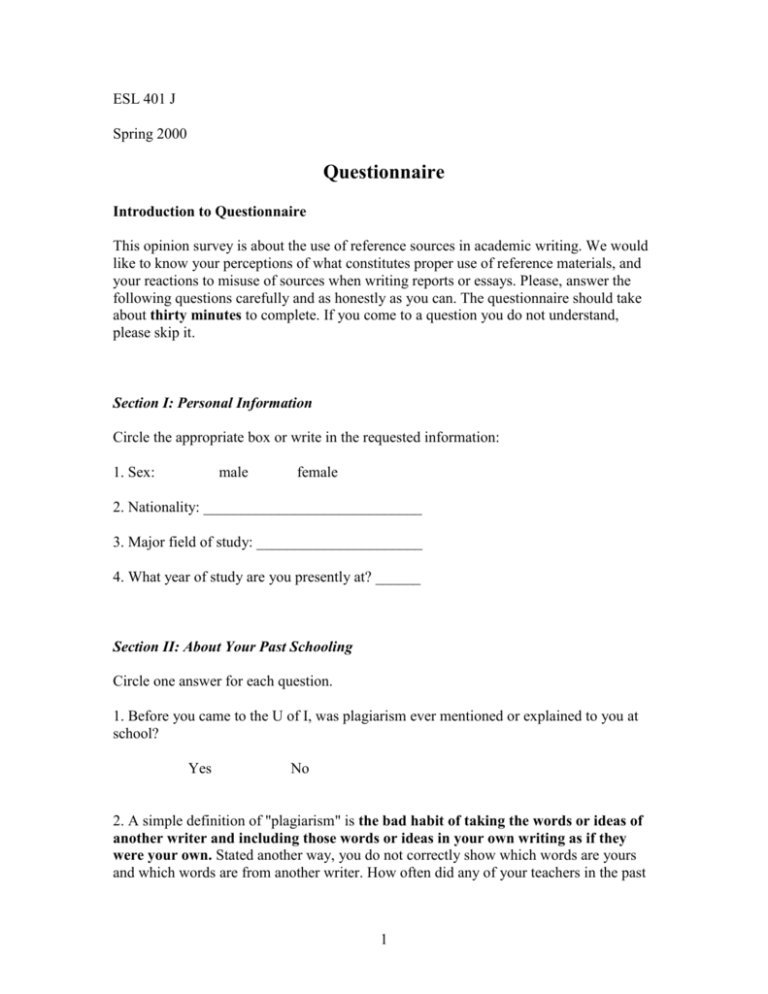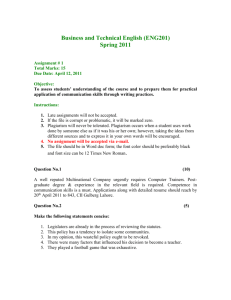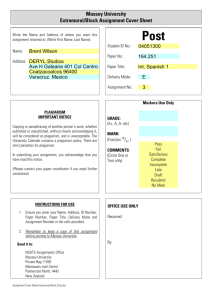ESL Plagiarism Questionnaire: Academic Writing & Source Use
advertisement

ESL 401 J Spring 2000 Questionnaire Introduction to Questionnaire This opinion survey is about the use of reference sources in academic writing. We would like to know your perceptions of what constitutes proper use of reference materials, and your reactions to misuse of sources when writing reports or essays. Please, answer the following questions carefully and as honestly as you can. The questionnaire should take about thirty minutes to complete. If you come to a question you do not understand, please skip it. Section I: Personal Information Circle the appropriate box or write in the requested information: 1. Sex: male female 2. Nationality: _____________________________ 3. Major field of study: ______________________ 4. What year of study are you presently at? ______ Section II: About Your Past Schooling Circle one answer for each question. 1. Before you came to the U of I, was plagiarism ever mentioned or explained to you at school? Yes No 2. A simple definition of "plagiarism" is the bad habit of taking the words or ideas of another writer and including those words or ideas in your own writing as if they were your own. Stated another way, you do not correctly show which words are yours and which words are from another writer. How often did any of your teachers in the past 1 schooling ever tell you (i. e., by means of spoken or written comments) that you have made this kind of mistake in your own written work? never 1 or 2 times more than two times 3. In your own opinion, to what extent do you feel you yourself copied the words or ideas of other writers without indicating the source in your writing assignments for school? Please, answer this question without considering whether or not you understood what might be wrong with such a habit. never did it did it a little bit did it a lot Section III: Recognizing Plagiarism Below is a part of a newspaper article a student might use to help him/her in writing a report on the topic "Loss of Tropical Forests". Read it carefully so that you can recognize the different ways it is used in the series of student writing samples that follow. After reading each sample, you must decide if and to what extent the writer committed plagiarism, that is, copied or used it in a bad way. Simply put a tick in one of the boxes for each sample. NOTE: Be sure to tick an answer for each of the six samples. PLEASE, TAKE ABOUT 20 MINUTES TO DO THIS PART. Do not rush; rather, work carefully. (This exercise is adapted from Deckert, G. D. (1993). "Perspectives on Plagiarism From ESL Students in Hong Kong" Journal of Second Language Writing 2 : 2, 131-143). GLOOM OVER TROPICAL FORESTS* by Philip Shabecoff International Herald Tribune, June 9, 1990, p. 3. Tropical forests, which play a vital role in regulating the global climate, are disappearing much more rapidly than previously estimated, according to an international research group. Each year recently, 40 million to 50 million acres (16 million to 20 million hectares) of tropical forest have been lost as trees are cut for timber and land is cleared for agriculture and development, the World Resources Institute said in its 1990 report. According to this study, the rate of loss in most countries was nearly 50% more in 1987 than in 1980. The report said 1.9 billion acres of tropical forest remained... 1* From "Loss of Tropical Rain Forests Is Found Much Worse Than Was Thought" by Philip Shabecoff, The New York Times, June 8, 1990. Reprinted in International Tribune, June 9, 1990. Copyright 1990 by New York Times Company. Adapted by permission. 2 Sample A The world is losing its valuable forests at an alarming pace. The Earth's forests which are an important factor in the Earth's climate, were disappearing more quickly in 1987 than previously estimated in 1980. Recently, 40 million to 50 million acres of tropical forest have been lost each year. This is because some forests are cut for timber and some are cleared for other purposes. The group says 1.9 billion acres of tropical forest remain. * ______________ * P. Shabecoff, International Herald Tribune, June 9, 1990, p. 3. [ ] The student committed no plagiarism, i. e. no wrong use of the source. [ ] The student committed some plagiarism, i. e., some wrong use of the source. [ ] The student committed a great amount of plagiarism, i.e., a great amount of wrong use of source. Sample B The world is losing its valuable forests at an alarming pace. Tropical forests, which play a vital role in regulating the global climate, are disappearing much more rapidly than previously estimated. An international research group reported that each year recently 40 million to 50 million acres of tropical forest have been lost as forests are cut for timber, and land is cleared for agriculture and development. The rate of loss was more in 1987 than in 1980. The group said 1.9 billion acres of tropical forest remained. * ____________ * P. Shabecoff, International Herald Tribune, June 9, 1990, p. 3. [ ] The student committed no plagiarism, i. e. no wrong use of the source. [ ] The student committed some plagiarism, i. e., some wrong use of the source. [ ] The student committed a great amount of plagiarism, i.e., a great amount of wrong use of source. 3 Sample C The world is losing its valuable forests at an alarming pace. According to recent research done by an international research team, the Earth is losing up to 50 million acres of forest each year. According to the investigation, the rate of loss increased by 50 % from 1980 to 1987. The 1990 report indicates 1.9 billion acres of forest remain on Earth. A major concern is that this loss may greatly affect patterns of climate. [ ] The student committed no plagiarism, i. e. no wrong use of the source. [ ] The student committed some plagiarism, i. e., some wrong use of the source. [ ] The student committed a great amount of plagiarism, i.e., a great amount of wrong use of source. Sample D The world is losing its valuable forests at an alarming pace. Forests, which are an important factor in climatic patterns, are being rapidly cut back for timber, agricultural needs, and land development. Studies over the past decades indicate that the rate of loss increased by 50% between 1980 and 1987. At present there is less than two billion acres of forest remaining, and about 40 to 50 million acres are being lost annually, according to the World Resources Institute.* ____________ * P. Shabecoff, International Herald Tribune, June 9, 1990, p. 3. [ ] The student committed no plagiarism, i. e. no wrong use of the source. [ ] The student committed some plagiarism, i. e., some wrong use of the source. [ ] The student committed a great amount of plagiarism, i.e., a great amount of wrong use of source. Sample E The world is losing its valuable forests at an alarming pace. Philip Shabecoff, summarizing a report based upon a recent study done by the World Resources Institute, states, "Each year recently 40 million to 50 million acres ... of tropical forest have been lost as trees are cut for timber and land is cleared for agriculture and development" (Int' l Herald Tribune, 9 June 1990, p. 3). According to the same study, the Earth now has less than two billion acres of forest, and the rate of loss is increasing. The loss of forests can 4 affect global climate. [ ] The student committed no plagiarism, i. e. no wrong use of the source. [ ] The student committed some plagiarism, i. e., some wrong use of the source. [ ] The student committed a great amount of plagiarism, i.e., a great amount of wrong use of source. Sample F The world is losing its valuable forests at an alarming pace. A recent article in the International Herald Tribune gives the findings of the World Resources Institute. The findings in this 1990 report are that "at present, each year between 40 million and 50 million acres of forest disappear because people cut them down for wood or remove them to make the land ready for other requirements and only 1.9 acres remain". * Losing so much forest land might affect the climate and cause serious problems. ____________ * P. Shabecoff, International Herald Tribune , June 9, 1990, p. 3. [ ] The student committed no plagiarism, i. e. no wrong use of the source. [ ] The student committed some plagiarism, i. e., some wrong use of the source. [ ] The student committed a great amount of plagiarism, i.e., a great amount of wrong use of source. Summary Question: Look at the one or more writing samples you rated as having " a great amount of plagiarism". Then circle the letter of the sample, which showed the worst case of plagiarism. A B C D 5 E F Section IV: Why Is Plagiarism Unfair? Look again at the sample you chose as the worst case of plagiarism, that is, the writing sample that made the most incorrect use of the newspaper article. To whom is its writer unfair and why is it unfair? To give your opinion, read each of the following statements and rate on a scale of 1-4 your level of agreement by circling one of the possible numbers. If you have no opinion about a statement, circle "No opinion." 1. When one writes this way, he/she is unfair to himself/herself because he/she is not being himself/herself. Rather, he/she is pretending to be better than he/she is. I strongly agree 1 2 3 4 I strongly disagree No opinion 2. When one writes this way, he/she is unfair to the university because it runs counter to the university educational goals which can never be achieved if students just copy information. I strongly agree 1 2 3 4 I strongly disagree No opinion 3. When one writes this way, he/she is unfair to the writer of the original passage because he/she is taking the credit that the writer deserves for the words and ideas. I strongly agree 1 2 3 4 I strongly disagree No opinion 4. When one writes this way, he/she is unfair to class as everybody is processing information in his/her own language whereas by plagiarizing sometimes one may get the same or a better grade. I strongly agree 1 2 3 4 No opinion 6 I strongly disagree






